Alternative Spring Break 2020
Started in 2013 by faculty member Kim Schroeder, the School of Information Sciences' Alternative Spring Break is a competitive program in which chosen applicants are paired with one of the country's premiere information organizations for an intensive week-long internship that aligns with the student's area of interest.
Since the program's inception, participating students have gained experience by working at a variety of institutions, including the Smithsonian, Library of Congress and several presidential libraries throughout the country.
This unique hands-on experience can make a huge difference as students graduate and transition to the work force. Some students have even received job offers from their host institutions upon completion of the program.
“The most important thing for students is knowledge of day-to-day work in the field, and to have a full picture of what it looks like in the workplace,” said Schroeder. “The second most important thing is making contacts – it’s vital for finding a job. I always see a big change in the students who have completed this program. Their confidence increases, they’re more comfortable interviewing, and they usually get jobs more quickly after graduating as a result of having this practical experience.”
ASB alumni overwhelmingly agree that the week-long experience provides them with a sense of accomplishment, new connections, insights into the profession and valuable skills that they will use in their careers.
“When the week was over, I felt like I had learned so much. I had gained practical experience, met some of my classmates face-to-face, and built connections with some of the archivists,” said Ashley Cabala. “I would strongly encourage any archive student to participate in Alternative Spring Break.”
The university's 2020 spring break took place March 9-14, just as the COVID-19 coronavirus began affecting universities, libraries and organizations across the U.S. Some of the students' ASB experiences were cut short due to closures, providing participants with an especially memorable experience. Despite the disruption, each of the students had the opportunity to take their classroom theory into cultural institutions and gained valuable insight and skills related to the profession that they will carry with them as they begin careers in the field of information sciences.
“My experience at the Reuther library for Alternative Spring Break was great,” said Julia Grannan. “Finishing the processing of that collection made me feel accomplished. I honestly feel like I learned a lot and that I am one-step closer to becoming an archivist myself. I will forever be thankful for this experience.”
Students who participated in this year's Alternative Spring Break program share first-person accounts of their experiences below.*
Ashley Cabala
Walter P. Reuther Library, Detroit, Michigan
The School of Information Sciences at Wayne State tries to prepare students for the real world outside of school. This is done in many ways through our classes, but the school also offers unique opportunities like Alternative Spring Break that gives students the chance to get hands-on experience in the archival field. What we learn in our classes is wonderful, but the chance to apply that knowledge is one that no archival student should pass up. It takes all the theory we've learned and shows its practical applications and gives a better understanding of why these standards are in place.
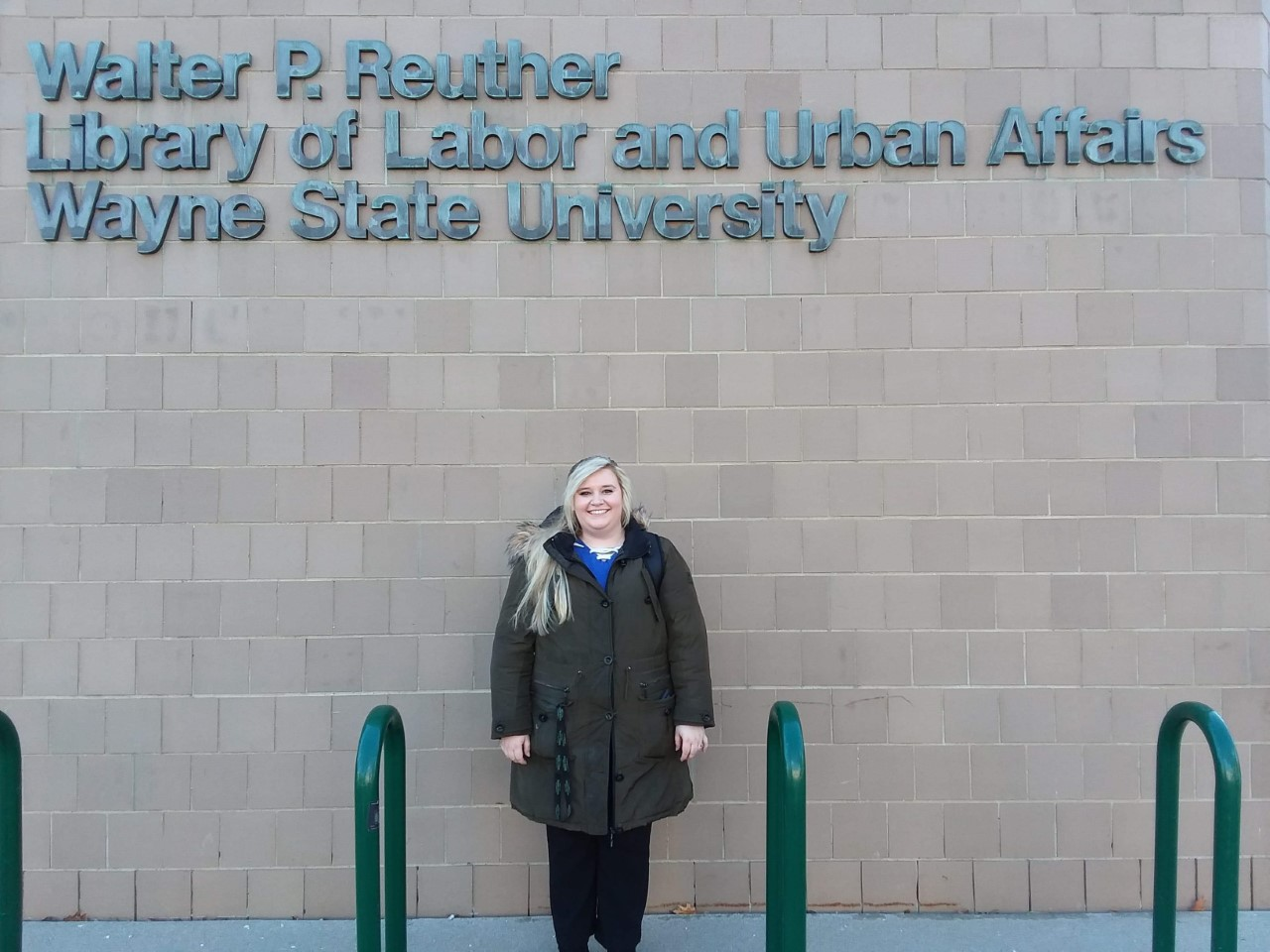
During my undergrad I worked for four years at a small university archive. Although it was a wonderful experience that provided me with a lot of knowledge, I had limited oversight and assistance from an archivist.
Alternative Spring Break was an opportunity to see how an archive should function and what it is like to be an archivist for a week. I was placed at the Walter P. Reuther Library where I was one of three students who worked alongside two of the Reuther's archivists. From the very beginning it was a wonderful experience. Both archivists were warm and welcoming, and having been recent graduates themselves, were able to offer valuable insight. The archivists urged us to ask questions and we spent time discussing their jobs and how they got where they are now. It was so refreshing to see an archive that had policies and procedures in place, to see a group of people who were passionate about their jobs, and to get their feedback on the work that we were doing.
The three of us each got a collection to process from beginning to conclusion, with a searchable finding aid that had our names attached to it. This was wonderful because at the time I was taking in the Description and Access class and this gave me the opportunity to apply skills that I was learning about in class. This came especially useful as I was shown how the Reuther archivists use EAD and ArchiveSpace.
Each collection was different and so it was interesting to see the various materials that each of us would uncover. I was given the Fred Lodge Papers. Fred Lodge was the International Representative from UAW Region 6. His collection was interesting because it contained two important aspects of his life: one half were documents from the UAW, and the other contained research on extremists and right-wing political groups. The UAW documents contained expected material like correspondence, but also contained many grievances filed by UAW members. My dad currently works on the line at GM, so it was interesting to see the hardships that the workers used to experience. I also learned that Fred was asked to be part of a task force the researched the extremist groups, as many of them were against unionism.
I ended up finishing the collection a day early. Instead of being told to go home, the archivists took the time to ask what else we were interested in learning about. I was then shown some of the projects they are working on with digital archiving. It was so cool to be introduced to programs like Archive It and Twarc and to see them being used in a practical setting. When the week was over, I felt like I had learned so much. I had gained practical experience, met some of my classmates face-to-face, and built connections with some of the archivists.
I would strongly encourage any archive student to participate in Alternative Spring Break. Kim Schroeder made the process of getting ready for it so easy. If you get the chance, I would also recommend that students visit the Reuther Library. The staff there is incredible and want nothing but success for the students who go there.
Rachel Crouch
Walter P. Reuther Library, Detroit, Michigan
I was given the opportunity to participate in the School of Information Sciences' Alternative Spring Break program. The assignment I was given was at Wayne State University's own Walter P. Reuther Library in Midtown Detroit.
While there, I was given a brief tour of the archival collections and shown around the building. I had the chance to work with Sarah Lebovitz, the SEIU Archivist and Shae Rafferty, the Labor and Union Affairs Archivist. I worked on the "Citizens of Michigan Records," and was able to work on helping to organize and process the materials. The collection consisted of materials on correspondence, committee meeting information, reports, minutes, mailing lists and newspaper clippings. It had not been fully processed since it was originally received in 1969. While looking over the collection we also were given a processing plan to help organize the collection.
My fellow students (Ashley Cabala and Julia Grannan) and I were then able to start some of the processing and going through the materials to find any general physical conservation issues. Some issues I came across were rubber bands, rusted metal paperclips, envelopes and duplicates. Later in the week I took the time to handle arrangement of the records and made decisions on what the best practice would be for organizing the collection. Since part of the collection had at one point been processed, I chose to keep the collection in the same series as it originally was in.
On my final day I worked with two of the archivists to go over the digital face of my project. I placed all the data from the folders and content that I had worked on in a coded excel format resource record which was sent to the archivist who converted the text inventory to EAD, which was processed through Archives Space. It can now be viewed online at http://as.reuther.wayne.edu/repositories/2/resources/3257.
Overall, I found the experience to be really helpful and useful in getting hands-on experience in processing an archival collection.
Johana Flores and Madison Mosely
Jimmy Carter Presidential Library and Museum, Atlanta, Georgia
Our Alternative Spring Break assignment took us to the Jimmy Carter Presidential Library and Museum, located in the heart of Atlanta. In true Southern hospitality, the staff at the Carter Library welcomed us with open arms and provided us the kind of experience of which interns can only dream. Not only did we work on several projects over the course of the assignment, we were given tours of both the archives and the museum and learned about the intense and delicate work that goes into their maintenance and continued use.
We had a fascinating discussion with the museum curator, who shared with us her experience with a few successful exhibits as well
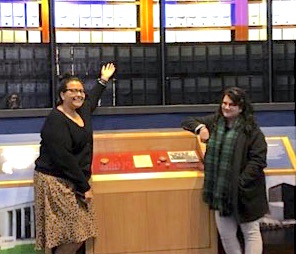
as the challenges she faced due to certain organizations' intellectual property rights. She said it was a learning experience for her because intellectual property was not something that she was very familiar with before this experience. It was interesting to hear how she had to deal with it and how some organizations were more organized and willing to help while others were not.
We were given a robust experience from all employees at the Carter Library during a time of uncertainty, as the realities of COVID-19's spread to North America became ever more present. This also gave us insight into how a presidential library might respond to an unprecedented crisis. We watched as administrators made decisions for the well-being of their staff and archivists planned for the possibility of working from home by positioning projects for out-of-office work.
Our time at the Carter Library was split in half by two projects. Jimmy Carter had a very well-documented presidency which is highlighted by the White House Photographer Collection. Part of our work was digitizing the black and white photographs from this extensive collection that consists of 20,000 negative reels. The A/V archivists took us through the process of correct storage and removal procedures before showing us how they digitize the photographic negatives. Our work in the A/V lab consisted of digitizing the negatives into TIFF files and using their contact sheets to extract metadata. We used DACS as the standard for recording metadata. Something we found interesting was that we scanned the photographs twice - once at 3400 DPI and the second at 2400 DPI. The higher resolution image became the master copy from which no copies are to be made as to protect the integrity of the image. The purpose of the second copy is to be saved for any future reference request.
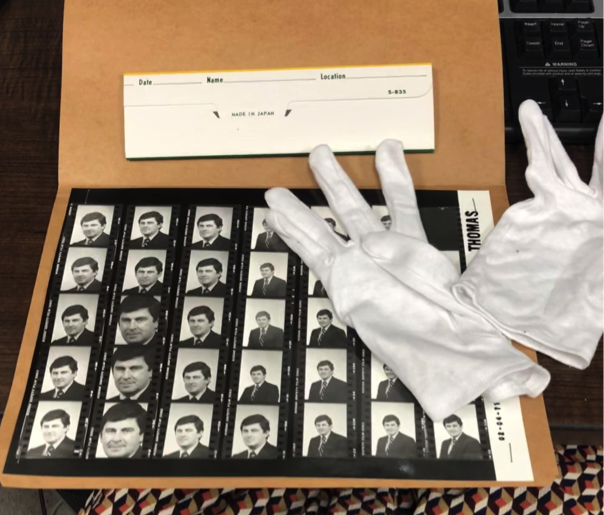 Our second project was extensive primary source research, with the goal to create a story that, in the future, will be added to the Google Arts & Culture site. We were offered a few subjects from Jimmy Carter's presidency to choose from, Johana selected the 1980 Olympic Boycott and Madison selected the first-ever White House Solar Panels. In order to gain access to the collection, we received an orientation from one of the archivist specialists and applied for a researcher's card. Due to security reasons, we personally did not have access to the stacks, but we were able to get a glimpse of the repository holdings. We came across memorandums, correspondence, rough drafts of speeches, news articles, administration associate documents and more. We were also able to view contact sheets, similar to the ones that we assisted the A/V team with digitizing, which brought the value of our work full circle as the contact sheets provided information relevant to our research.
Our second project was extensive primary source research, with the goal to create a story that, in the future, will be added to the Google Arts & Culture site. We were offered a few subjects from Jimmy Carter's presidency to choose from, Johana selected the 1980 Olympic Boycott and Madison selected the first-ever White House Solar Panels. In order to gain access to the collection, we received an orientation from one of the archivist specialists and applied for a researcher's card. Due to security reasons, we personally did not have access to the stacks, but we were able to get a glimpse of the repository holdings. We came across memorandums, correspondence, rough drafts of speeches, news articles, administration associate documents and more. We were also able to view contact sheets, similar to the ones that we assisted the A/V team with digitizing, which brought the value of our work full circle as the contact sheets provided information relevant to our research.
Overall, our time at the Jimmy Carter Presidential Library was an invaluable experience we will not soon forget. Not only did we learn so much from the amazing staff at the library, but it affirmed our career choices. Thank you to Kim Schroeder for coordinating this experience and Christopher Geissler for providing us with the experience of a lifetime (even during the beginning of a pandemic)!
Julia Grannan
Walter P. Reuther Library, Detroit, Michigan
Staying on campus during spring break to work may not sound like the best way to spend said break, but when that work involves handling pieces of history, it becomes a lot more interesting. It also helps that I am not from the area, but from a few hours south in Ohio. This made the experience of exploring the university and Midtown Detroit seem much more like a break to me.
I must admit that I have never actually worked in an archive before. This experience was brand new for me. I was excited to see what the week would bring, but nervous about starting something new. On the first day I woke up early, ate a quick breakfast, and excitedly set out down the street to the library. I began my week with introductions to the other two interns and the archivists at the Reuther who we would be working with. I knew after meeting them that our week would be anything but boring. And it definitely was not boring (in more ways than one). After a classroom-inspired introduction, we were given a rundown of what we would work on during the week. I was given the job of processing five boxes of documents from a Detroit union local.
The first day was a bit daunting. I had never processed anything before, so looking at five boxes full of documents I had to somehow make sense of was intimidating. However, the archivist I worked with was extremely helpful and did not seem to mind my plethora of questions. I am very thankful for her patience and excitement. She definitely helped make the week entertaining. She also showed me the fun to be had while looking through collection boxes. I found old phone service bills, a manual for a refrigerator from the 1960s, early 2000s cell phone pamphlets, and even some stray confetti. There is always something interesting to be found in these boxes.
Along with learning how to process a collection, I was able to create a finding aid. Again, this was something I had never done before. I have learned about it in class, but it something different to be able to actually make one yourself. You really do get a better understanding of it. This finding aid is also something tangible I have to show for my week there. My name is now officially attached to a collection at the Reuther Library. If you search hard enough, you may even find it.
The whole week went by relatively quickly. We were able to finish our processing and finding aids with enough time to explore more of the archive. This included a tour of the audiovisual materials and being shown how they are copied and utilized. It was interesting to see another side of archives that I am not used to and didn't work with over the week. Overall, it was a nice way to end the week.
My experience at the Reuther library for Alternative Spring Break was great. I really enjoyed what I did and meeting all of the archivists that work there. Finishing the processing of that collection made me feel accomplished. I honestly feel like I learned a lot and that I am one step closer to becoming an archivist myself. I will forever be thankful for this experience.
Kathryn Gstalder
National Records and Archives Administration (NARA), Chicago, Illinois
My experience at NARA's Chicago/Great Lakes Region branch provided me with new skills and broadened my view of archival practices. My Alternative Spring Break only lasted two days due to health concerns due to COVID-19 and NARA's resulting closure of their research room. However, in my two days on site, I gained new insight into the field of archives within a government setting and I met insightful professionals who were willing to share their knowledge with me.
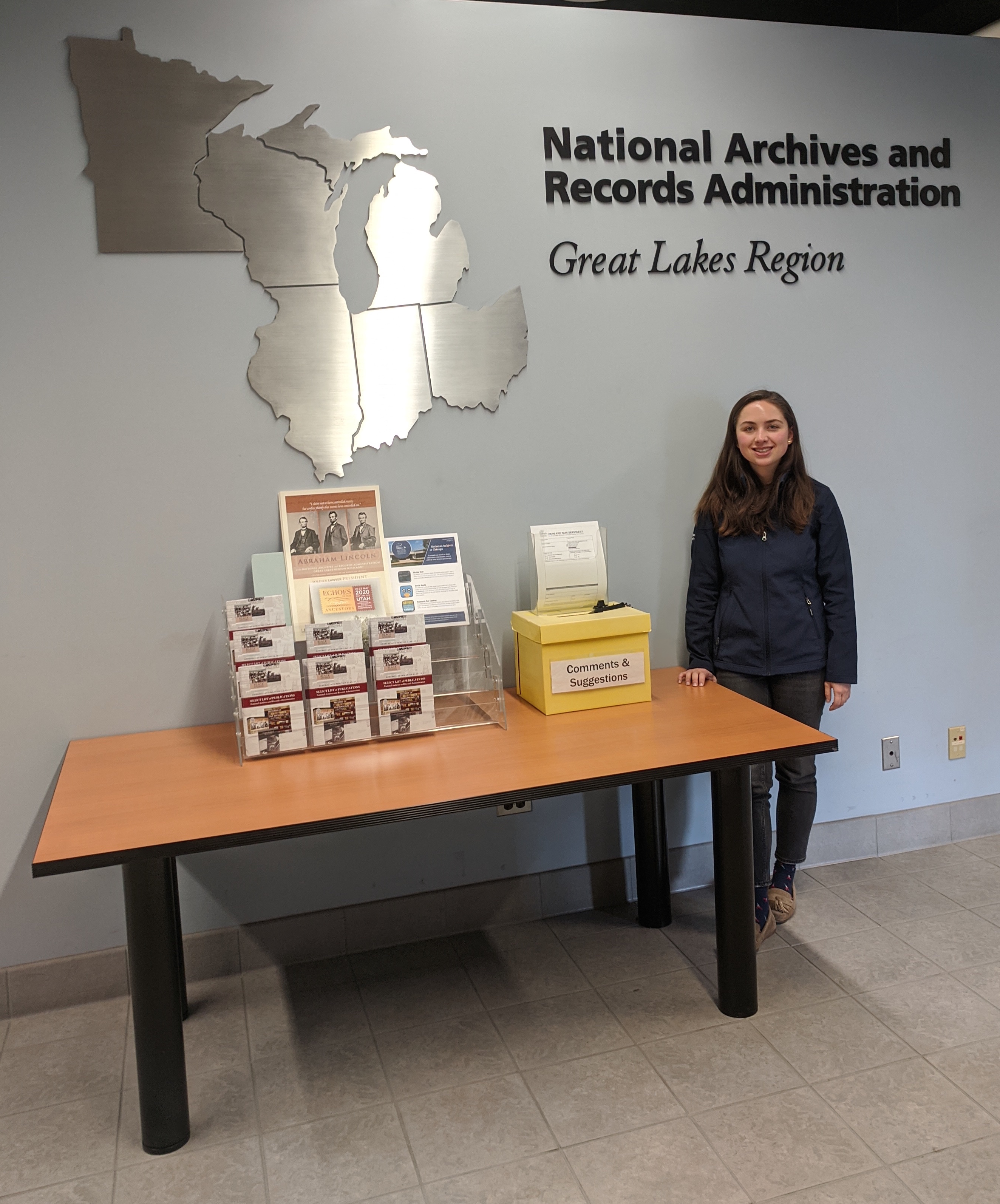
The morning of my first day, the project manager gave me a tour of the facilities, and the vastness of their holdings cannot be understated. There are three warehouses for records, and one warehouse for the archives. Their records take up the majority of the space, as only approximately 1 to 3 percent of records end up in the archives at the end of their lifecycle. Because of the huge amount of items processed at NARA, the standard for processing is simply to have arranged the holdings into collection and then series level. This level of description is considered "processed," which I was surprised to learn. In my experience working in corporate archives, we have a much smaller amount of material, and we take our description to a much greater level of detail.
After touring the records and archives warehouses, the manager acquainted me with my project. It entailed processing part of NARA's Bureau of Indian Affairs (BIA) holdings. I worked, in particular, on a series of documents which contained receipts, or vouchers, of purchases made by various tribes in the Wisconsin region in the early 1900s. I was told that living descendants of tribe members referenced in these BIA holdings have visited the NARA Chicago location in order to conduct ancestral and other research.
For the remainder of my first day, and the beginning of my second day, I arranged the documents chronologically (their original order had already been disrupted) and re-foldered some items with poor binding and folder conditions. I examined and kept notes on the content and scope of the materials. After completing the processing, I printed labels for the archival boxes and then shelved the boxes, keeping note of which boxes were on which bay and shelf. With the guidance of an employee, I learned how to navigate NARA's cataloging system and input description of the materials I'd processed using DAS standards (Description and Authority Service).
This was the bulk of my two-day experience at NARA Chicago. The remainder of my week was scheduled to work on a correspondence series within the BIA holdings, however I did not get to work with those materials because of the closures.
This experience provided me with the skills of working with a new cataloging system and with different description standards. As the manager explained to me, NARA exists to keep record of materials created by the U.S. federal government and has no other collection mission. For instance, while many people call NARA Chicago hoping to find information about the 1893 Chicago World's Fair, NARA has little to offer on the subject and wouldn't collect such items unless they were produced by the federal government. Museums and other institutions' archives are generally quite different from NARA in this regard. Even though NARA doesn't have an external collection mission, the federal archives contains fascinating and useful materials, from immigration records to the documentation of the Chicago Seven appeals case. I am grateful to have had this professional experience in a unique archival setting.
Kaitie Martinelli
Freer Gallery of Art and Arthur M. Sackler Gallery, Washington D.C.
Hello fellow Warriors! For my Alternative Spring Break, I was sent to the Freer/Sackler Gallery of Art at the Smithsonian in Washington, D.C. I had the pleasure of working with archivists Ryan Murray and Lisa Fthenakis, and was tasked with processing Series Two of the James Cahill papers.
After studying in Japan, Cahill started his career as the curator of early Chinese art at the Freer Gallery of Art, before moving on to

his tenure professor position at the University of California, Berkeley, where he remained until his retirement in 1995. Cahill has been regarded as one of the world's top authorities on Chinese art, as well as an author of more than two dozen books. One of the first things I was told upon my arrival to the archives however, is that he also was known for being one of the most unorganized people in the world. Further, the last finding aid was made as far back as 2008, and almost nothing matched the folder or box number. This would turn out to be one of the biggest problems that I would face while processing this collection.
The collection is split into two series. Series One is regarding various files on projects he created or had been involved in. Series Two, is regarding his various correspondences with individuals. Because of the complexity, size and unorganized nature of the collection, the archivists decided it was best for me to try and work through Series Two only. It was also decided that due to the unorganized nature of the collection, no box and/or folder number would be assigned. It would be best for me to go through the whole collection first, and organize it from there. It is important to note that while working through the process, I alphabetized according to what Mr. Cahill had written on the previous folders I found in the boxes, and to add quotation marks around the names. For example, if he wrote "Mr. Smith" or "Smith, Joe," or "Joe Smith," I would file that under "S." However, I was informed by the archivists later that upon my completion of processing the collection, they might make the decision to alphabetize the collection solely according to what Mr. Cahill had written on the folder. So, "Joe Smith" would be filed under "J." I also took great care to dispose of any rubber bands or metal paper clips, as those items can damage the documents.
I was happy to have gained experience handling photographs and using Mylar sleeves. I had multiple Mylar sleeves of every size at my disposal. However, because some of the photographs were thrown in a box together, emulsion to emulsion, several of them were stuck together. These were given to the archivists for different care that was needed. While I worked on processing the collection, I had many conversations with the archivists in the room about what they do on a daily basis, to get a general scope of the job. I was surprised that none of them really said anything about processing. As someone who was witnessing the archivists tasks, there was never really a time where it seemed like they had much downtime. One was always in a meeting, sending emails, working on providing documents for future researchers or even writing a lengthy proposal for a museum grant. Overall, this was a really great experience. As someone who has never done anything in archives besides research, it was a great introduction. I look forward to gaining more experience in this interesting field.
Julie Miller
Hoover Presidential Library and Museum, West Branch, Iowa
Over spring break I, along with Ginny Schneider, another graduate student from Wayne State, interned at the Hoover Presidential Library in West Branch, Iowa. I spent the week working on various archival projects and received mentoring (as well as funny stories) from our wonderful supervisor, Craig Wright (Supervisory Archivist).
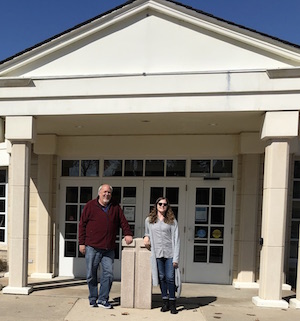
One project involved the digitization of photographs of Lou Henry Hoover, President Herbert Hoover's wife. The photographs consisted of some portraits and some depicting her life as a mother. The photographs were of excellent quality so it was easy to obtain digital images. I learned how to adjust the size on the scanner for the variety of photograph sizes and how to do an initial scan before the definitive scan to verify settings are adjusted correctly. I learned the importance of minimally scanning the photographs to avoid excessive light exposure to preserve them for as long as possible.
Another project involved assisting my supervisor with a quality assessment of the Hoover Archives. I randomly chose 10 accession numbers from the archival database, then verified the accession numbers were where they should be in the archives. Then, I chose 10 different accession numbers in the archives and verified their proper location identification in the database. This process uncovered a minor labeling issue that was fixed. This procedure is done a couple times a year to check the quality of the archival filing system. Another project consisted of rearrangement of items in proper chronological order so that it would be more accessible for patrons and staff. The last project I worked on was my favorite. It involved assigning metadata for the Hoover scrapbook collection. The Hoover scrapbooks were extraordinarily rich with wonderful photographs and descriptions. I could have spent a year appreciating the photographs and details in those scrapbooks. Some of the scrapbooks were gifts to President Hoover from countries that he helped during the food relief efforts and others documented early stages of the Hoover Dam construction.
When I wasn't working on projects, I met with staff and volunteers to learn about their work at the library. One evening I met with Lynn Smith (Audiovisual Archivist) and learned about the Rose Wilder Lane and Laura Ingalls Wilder collection at the Hoover Presidential Library and the connection between President Hoover and the mother/daughter Wilder collections. Lynn also showed me an analog wire record player and she shared her current work challenge involving interoperability issues to convert Hoover home movies to a digital format for a researcher to view.
One evening my WSU colleague and I had dinner with Craig Wright, Matthew Schaefer, Outreach Archivist at the Hoover Library, and his wife Karen Mason, Curator at the Iowa Women's Archives, all of whom had worked for the Bentley Historical Library in Ann Arbor, Mich., and are members of Midwest Archives Conference (MAC). It was a real treat to network with three seasoned archivists informally over dinner.
In addition to our individual projects, we toured the Hoover Presidential Library, Museum and Archives. Our tour guide, Matthew Schaefer, presented information on President Hoover with enthusiasm, which made it quite enjoyable. We attended one staff meeting and it was interesting to hear what each staff member was working on and to learn about the upcoming Hoover Museum renovation. My colleague and I introduced ourselves at the meeting and shared our backgrounds with everyone. I felt very welcomed at the Hoover Presidential Library and I had a great week, full of learning, connecting, and exploring. Thankfully, I was able to complete my week at the library before it went into lockdown due to COVID-19.
Ginny Schneider
Hoover Presidential Library and Museum, West Branch, Iowa
The majority of careers I have pursued involve wearing dozens of hats disguised as one. Interior designer, customer service rep, user experience designer and archivist all require the ability to switch gears at any given moment. Since 2019 I worked with smaller historical societies and their archives. I must say I enjoy working at smaller archives, but it is important for me to gain experience at various institutions. There is a phrase I learned a few years back that always puts my work into perspective, "You are not the target user." When I was offered the chance to spend Alternative Spring Break at the Herbert Hoover Presidential Library and Museum, a larger institution with a different set of users, I seized the opportunity.
The Hoover Presidential Library and Museum is located on the grounds of the Herbert Hoover National Historic Site, surrounded by
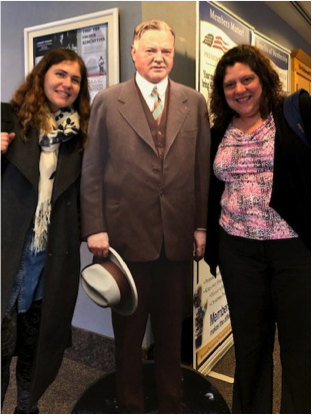
expected sites such as Hoover's birthplace cottage and unexpected ones like the Statue of Isis. Prior to arriving, archivist Craig Wright introduced himself to my fellow ASB archival traveler Julie Miller and I, informing us of the many possibilities we could take advantage of during our one-week stay. This included a massive list of all the audio-visual material they accumulated over the years, metadata projects and educational projects among others. I was both excited and overwhelmed by the vast array of choices. Working with Craig helped alleviate any intimidation I felt toward our options. He was welcoming and supportive, and shared lessons learned throughout his career through the duration of our visit.
On our first day outreach archivist Matthew Schaefer gave an excellent tour of the museum and overview of the reading room services. In addition to learning about Hoover's life, Matt provided insight as to why certain exhibits were displayed in particular ways and commented on what was effective versus what could possibly be improved. He is clearly an expert in articulating history based on primary sources in an engaging way. Before this experience I had not considered the possibility of pursuing outreach services but seeing the infectious enthusiasm Matt was able to share made me rethink what I could offer future archive users.
During the museum tour, the exhibit on Camp Rapidan piqued my interest. Among the many projects Craig suggested we could work on, creating an educational tool for future children visiting the library and museum on field trips was an option. I decided I would dive into the collections relevant to Camp Rapidan and compile educational materials for that purpose. Craig pulled together relevant collections, shared finding aids and introduced me to audiovisual collections with Camp Rapidan material. In reviewing this material, we came across a box of Rapidan material that the staff was unaware of. Although much of the material ended up being duplicates housed elsewhere in the archives, it was an exciting day for everyone to inspect these items.
Unfortunately my trip was cut short due to an illness. The few days I did get to spend at the Hoover Presidential Library were enjoyable and I feel fortunate that I was able to take advantage of this opportunity. The most valuable part of the experience was sharing stories with the staff there and learning about their expansive experience in the field. I look forward to meeting more professionals in archives and reconnecting with this staff in the future.
Christine Taylor
Maryland State Archives, Annapolis, Maryland
I was given the opportunity to intern at the Maryland State Archives as part of the Alternative Spring Break program. I was particularly excited to intern here because I would be working in the digital imaging lab, which allowed me to gain experience in something new and exciting.
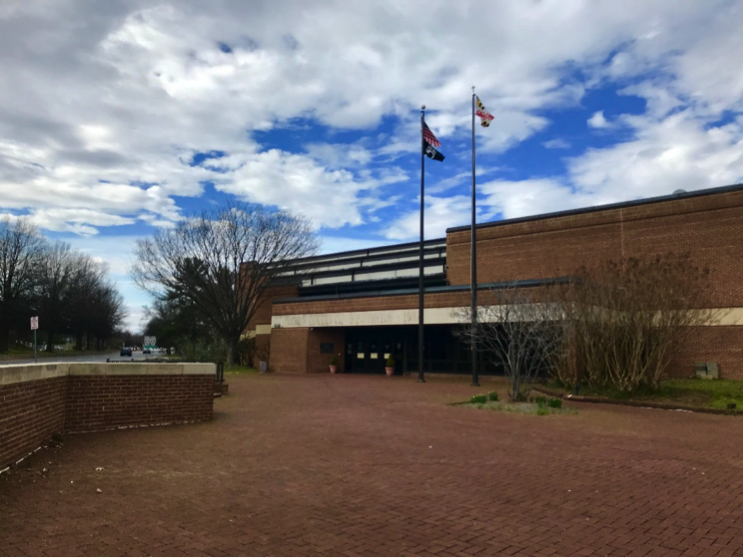
I had a great experience at the Maryland State Archives. On the first day, my fellow classmate, Karen Turk, and I were given a tour of the archives and shown some of the scanners we would be using.
The internship was unfortunately cut short to only 4 days due to the COVID-19 outbreak that began to spread. I was only a couple of days in when things began to take a turn for the worst. The number of cases was growing in Maryland and there were discussions about the archives being open essential personnel only. All other employees were preparing to work remotely.
Nonetheless, in the four days we were there, we rotated two main projects. The first project was scanning 18th century Chancery records into digital images. This project was a little monotonous, but I enjoyed getting the chance to use such a large scanner. It was also fascinating to look through the handwritten 18th century records. They contained beautiful handwriting that reminded me of the Declaration of Independence, and there were gorgeously drawn maps inside! Together we scanned approximately one 400-page book each day.
The second project they called "splitting bills," which was data cleanup. I sorted through hundreds of scanned microfilm images that contained house and senate bills. There was anywhere between 15 to 100 pages or more in each bill. I sorted through the microfilm images and saved each bill to their own separate file for ease of access.
In addition to the main projects we worked on, I was given tutorials on how some of the scanners work. For instance, I was given a tutorial of one of the Kodak book scanners. I have always been aware of the existence of book scanners, but I have never witnessed how one worked firsthand. To scan a book, it had to be unbound, then placed upside down and fed into the scanner. It was impressive to see how fast a 300-page book could be scanned and digitized in a matter of minutes!
Overall, I enjoyed my time at the Maryland State Archives, even with it being cut a little short. I was able to get introduced to a variety of new skills that will help build towards my career as a future archivist. I am very grateful for the opportunity that the ABS program has provided for me, and everyone that hosted us at the archives were very kind and informative.
Karen Turk
Maryland State Archives, Annapolis, Maryland
The week began with an unanticipated St. Patrick's Day parade in front of my hotel, replete with bagpipers and lots of green, and ended with me flying home early due to COVID-19 concerns. The actual archival work was less dramatic, though, with the overall experience being very instructive and positive.
During the week, I supported various initiatives in the imaging department, where the archives staff is committed to providing a broad
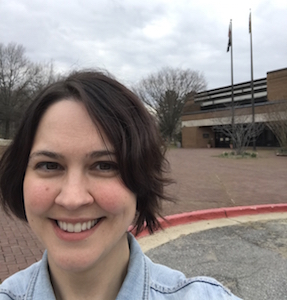
range of their services online. Through preservation activities and records management, the department is able to make state-wide verified land records accessible daily and approximately 500 county plat maps accessible monthly. One of the priority digitization projects is the Department of Legislative Service's Legislative History Project. Its aim is to make the documented history of every bill accessible online. I dedicated most of my time to assisting with the Legislative History Project.
Two post-processing tasks are necessary before the bills can be made available: splitting the bills and batch renaming. To split the bills, I had to use the application ACDSee 15. I would view hundreds of TIFF files created from scans of microfilm and separate them into their correct folders. The bills I worked with were from the late 1990s. I used an application aptly called Advanced Renamer to take the PDFs of the bills (eventually the TIFFs are converted to PDFs) and change their names to comply with the state's file naming conventions. This time I worked with bills from the early 1990s.
The final project had me working with much older records; I got to scan handwritten books of Chancery court records from the early 1800s. These books document equity cases or those related to mortgages, real or personal property, estate settlements, etc. Using a Shaw Scan Master 0, I was able to complete scans of five of these unique books (most of which were more than 500 pages long).
The Alternative Spring Break program gave me the opportunity to see how records management and archiving intersect at the governmental level in a way that I had only read about in my Records and Information Management class. I really appreciate the staff at the Archives for taking the time to welcome and train me during what I imagine was an otherwise stressful week!